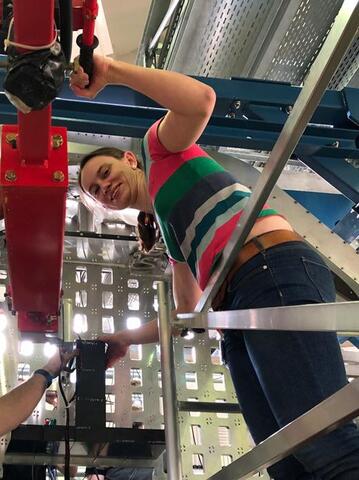Workshop „Physics Opportunities with Proton Beams at SIS100” was held in Wuppertal
PANDA meetings
04/03-08/03 2024 CM 24/1 in Münster
24/06-28/06 2024 CM 24/2 at GSI
25/06-26/06 2024 FEE/DAQ Workshop
04/11-06/11 2024 CM 24/3 at GSI
05/03-07/03 2025 WS at GSI
16/06-20/06 2025 CM 25 in Uppsala
This technical design report (TDR) illustrates the technical layout and the expected performance of the
luminosity detector (LMD) in the PANDA spectrometer. PANDA is an experiment performing physics measurements
in the high energy store ring (HESR) antiproton beam impinging on a crossing material target.
The LMD will reconstruct elastically scattered antiproton tracks to monitor the relative luminosity and to
extract the absolute luminosity mainly for absolute cross section measurements. We expect to determine the
luminosity with a precision better than 3%. However the accuracy of the systematic uncertainties coming
from the extraction method are expected to be better than 0.1%.
This document is divided into 7 chapters. First we motivate shortly the PANDA experiment and its setup.
Important aspects, specially of the FAIR accelerator complex, the PANDA target system and the PANDA
magnet setup, are pointed out from the view of the LMD as a basis for the understanding of the LMD design
and the expected performance.
The principles of the term luminosity and its measurement are topics of the Chapter 2. The fundamental
understanding of antiproton proton elastic scattering is the basis for the high precision extraction of the
luminosity. The physics model is discussed which is parametrized with experimental data. It is currently
therefore the main source for the systematical uncertainty and limiting the expected precision. Moreover
concepts of existing luminosity monitoring systems and benefits of a machine independent measurement are
explained to motivate a new type of luminosity detector for the PANDA experiment.
Chapter 3 digs then into details of the technical design which is driven by all the constraints from preceding
chapters. The emphasis is put on the construction and operation of the LMD. The motivation for special
solutions is kept short and referenced to results from our R&D process written down in later sections. Hardware
results from our R&D phase are put into chapter 4. This chapter presents our proof of concept and discusses
the status of our mechanical and electronic design studies.
The corresponding software analysis framework is explained in chapter 5. Up to now the performance of the
detector can only be estimated based on MC simulation studies which are treated off in this chapter as well.
All complications which we expect in the process of luminosity extraction are listed here and the influence on
our final accuracy is estimated.
As an integral part of a TDR our time lines as well as our human, material and financial resources are
discussed in chapter 6.
luminosity detector (LMD) in the PANDA spectrometer. PANDA is an experiment performing physics measurements
in the high energy store ring (HESR) antiproton beam impinging on a crossing material target.
The LMD will reconstruct elastically scattered antiproton tracks to monitor the relative luminosity and to
extract the absolute luminosity mainly for absolute cross section measurements. We expect to determine the
luminosity with a precision better than 3%. However the accuracy of the systematic uncertainties coming
from the extraction method are expected to be better than 0.1%.
This document is divided into 7 chapters. First we motivate shortly the PANDA experiment and its setup.
Important aspects, specially of the FAIR accelerator complex, the PANDA target system and the PANDA
magnet setup, are pointed out from the view of the LMD as a basis for the understanding of the LMD design
and the expected performance.
The principles of the term luminosity and its measurement are topics of the Chapter 2. The fundamental
understanding of antiproton proton elastic scattering is the basis for the high precision extraction of the
luminosity. The physics model is discussed which is parametrized with experimental data. It is currently
therefore the main source for the systematical uncertainty and limiting the expected precision. Moreover
concepts of existing luminosity monitoring systems and benefits of a machine independent measurement are
explained to motivate a new type of luminosity detector for the PANDA experiment.
Chapter 3 digs then into details of the technical design which is driven by all the constraints from preceding
chapters. The emphasis is put on the construction and operation of the LMD. The motivation for special
solutions is kept short and referenced to results from our R&D process written down in later sections. Hardware
results from our R&D phase are put into chapter 4. This chapter presents our proof of concept and discusses
the status of our mechanical and electronic design studies.
The corresponding software analysis framework is explained in chapter 5. Up to now the performance of the
detector can only be estimated based on MC simulation studies which are treated off in this chapter as well.
All complications which we expect in the process of luminosity extraction are listed here and the influence on
our final accuracy is estimated.
As an integral part of a TDR our time lines as well as our human, material and financial resources are
discussed in chapter 6.





